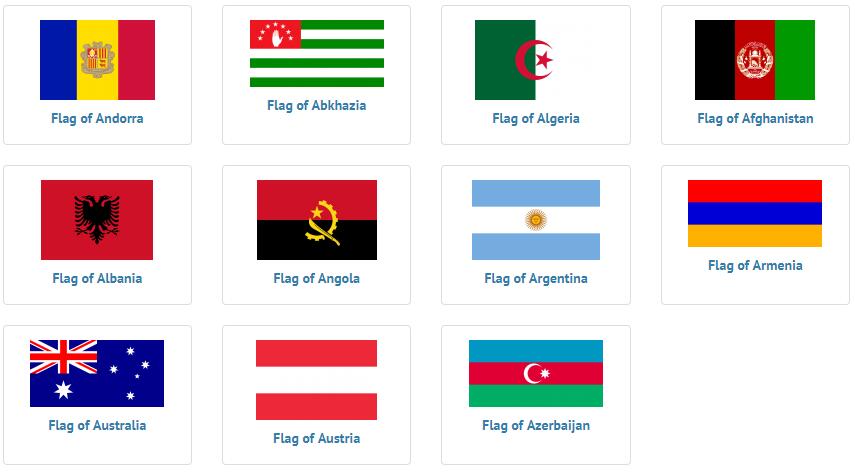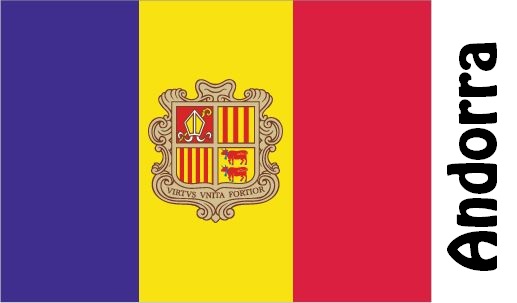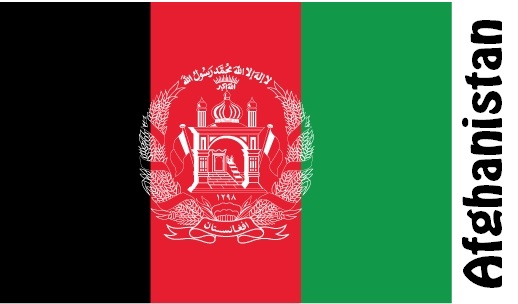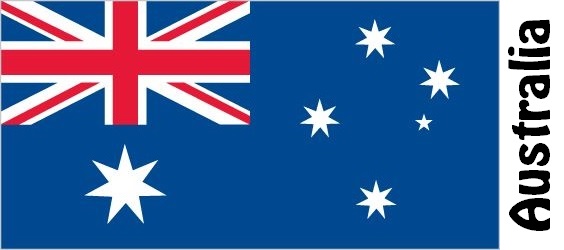Flags of Countries that Start with A
How many countries beginning with A? There are a total of 11 countries starting with letter A among the 193 countries in the world.
- African countries starting with A: Algeria, Angola
- Asian countries starting with A: Afghanistan, Armenia, Azerbaijan
- European countries starting with A: Albania, Andorra, Austria
- North American countries starting with A: Antigua and Barbuda
- South American countries starting with A: Argentina
- Oceania countries starting with A: Australia

Albania
Albania is a republic in southeastern Europe. The country lies on the Balkan Peninsula facing the Adriatic Sea and the Ionian Sea with borders to Greece, Montenegro, Macedonia and Kosovo. The landscape consists of mountain ranges, hills and low coastal plains.
The climate is subtropical along the coast, but temperate in the mountains to the east. Hot, dry summers and humid winters.
The economy is mainly based on agriculture. There is also mining for especially chrome, but also iron, nickel, bauxite, salt and plaster.
Albania is one of the poorest countries in Europe and has for many decades been plagued by great political and social turmoil. Since the 1992-99 Balkan crisis, Albania has become increasingly integrated into the rest of the European community. Albania joined NATO in 2009 and candidate country for the EU in 2014.
Country Facts – State Capital – Population Graph – Airports – Public Holidays – Embassies of Albania – Embassies in Albania – Import Regulations – Major Trade Partners – Major Imports – Major Exports
Andorra

Andorra is a small, independent republic in the Pyrenees mountain range between France and Spain. The land is 900-2,900 meters high and consists of valleys, plains, rivers and canyons, surrounded by high mountains. Less than 5% of the land is cultivated.
The climate varies according to the height of the sea from temperate to alpine climate with snowy, cold winters and relatively hot summers.
Andorra has very few natural resources, but the whole country receives energy from a single large hydroelectric power station.
Andorra is a duty-free area, which in particular receives revenue from the many people who visit the country, especially ski tourists and one-day tourists on luxury shopping. Andorra’s many banks with customers from all over the world are a major source of revenue for the country.
Country Facts – State Capital – Population Graph – Public Holidays – Embassies of Andorra – Embassies in Andorra – Major Imports – Major Exports
Austria

Austria is a Federal Republic of Central Europe. The country is an inland state surrounded by Germany, the Czech Republic, Slovakia, Hungary, Slovenia, Italy, Liechtenstein and Switzerland. The landscape is wooded and mountainous with highlands and is intersected by several mountain ranges, including. the eastern part of the Alps. In the island and the SE, as well as on the Danube river in the northern part of the country there is lowland.
The climate is temperate mainland climate with hot summers and cold winters. In the high mountains there is snow all year round.
The most important natural resources are wood, coal, oil, natural gas, iron ore, lead, tungsten, magnesium, zinc and copper ore. Trade, service and tourism, including Skiing is crucial to the economy.
After World War II, Austria was divided into four zones, respectively. France, the United Kingdom, the Soviet Union and the United States. The country became independent in 1955 and joined the EU in 1995.
Country Facts – State Capital – Population Graph – Airports – Public Holidays – Embassies of Austria – Embassies in Austria – Import Regulations – Major Trade Partners – Major Imports – Major Exports
Antigua and Barbuda

Antigua and Barbuda is an island state that includes the three islands of Antigua, Barbuda and Redonda. The islands are part of the Leeward Islands archipelago of the eastern Caribbean. The islands consist of corals and limestone. Antigua is of volcanic origin.
The climate is tropical and quite dry, dominated by the northeast pass. Hurricanes are frequent in the area.
The country gained independence in 1981, but has a monarchy within The Commonwealth. The economy is mainly based on tourism.
Country Facts – State Capital – Population Graph – Airports – Public Holidays – Import Regulations – Major Imports – Major Exports
Argentina

Argentina is a federal republic in the southern part of South America. The country has a coastline to the Atlantic Ocean and borders Chile, Bolivia, Paraguay, Brazil and Uruguay. Argentina consists of the Andes, forests and valleys in V, high plains in NV, rainforest area with large waterfalls in the NE, fertile plains and valleys in the central country and flat plateaus in S.
The climate varies greatly. There is subtropical in NE and V, desert-like in NV, temperate mainland climate centrally in the country and polar climate furthest to S.
The most important natural resources are oil, iron and other minerals. Industry, agriculture and oil exports are key to the economy.
Despite economic crises, Argentina is one of the most developed countries in South America.
Country Facts – State Capital – Population Graph – Airports – Public Holidays – Embassies of Argentina – Embassies in Argentina – Import Regulations – Major Trade Partners – Major Imports – Major Exports
Algeria

Algeria is a republic in North Africa. The country lies out to the Mediterranean and is surrounded by Tunisia, Libya, Niger, Mali, Mauritania, Western Sahara and Morocco. The majority of the country consists of the Sahara desert. To the N, the landscape is mountainous, the Atlas Mountains, with a narrow coastal plain.
The climate is subtropical. IN there is winter rain, and to the south there are bush steppe and desert with drought and large temperature fluctuations.
Algeria has some of the world’s largest reserves of natural gas and oil. Agriculture, forestry and fishing are also important for the economy.
Terror, violent demonstrations and clashes between militant Islamist groups and security forces occur.
Country Facts – State Capital – Population Graph – Airports – Public Holidays – Embassies of Algeria – Embassies in Algeria – Import Regulations – Major Trade Partners – Major Imports – Major Exports
Angola

Angola is a republic in southern Africa. The country faces the Atlantic Ocean and has borders with Congo (Democratic), Congo (Republic), Namibia and Zambia. Angola consists of a wide bedrock plateau and highland covered by savanna as well as desert and a narrow coastal plain.
The climate is tropical, very dry in S. The most important natural resources are oil, diamonds and minerals. Agriculture employs about 3/4 of the working population and is of great importance to the economy.
Portuguese colony until 1975. In the years 1975-2002 Angola was ravaged by civil war. The country’s economy and living standards are very poor. Angola relies on financial assistance from other countries.
Country Facts – State Capital – Population Graph – Airports – Public Holidays – Embassies of Angola – Embassies in Angola – Import Regulations – Major Imports – Major Exports
Afghanistan

Afghanistan is a republic in Southwest Asia. The country is an inland state surrounded by Pakistan, Iran, Turkmenistan, Uzbekistan, Tajikistan and China. Afghanistan is a country with mountains, glaciers, valleys, plains, deserts and limited access to fresh water.
Afghanistan has temperate mainland climate with extreme temperature fluctuations. There are hot, dry summers and cold, snowy winters.
Agriculture contributes to over half of GDP and employs approx. 3/4 of the workforce. The most important agricultural areas are the valleys and plains of the north and southeast.
Afghanistan is one of the poorest countries in the world and has been marked by war for many decades. Denmark has joined forces in the international coalition against the Taliban.
Country Facts – State Capital – Population Graph – Airports – Public Holidays – Embassies of Afghanistan – Embassies in Afghanistan – Import Regulations – Major Trade Partners – Major Imports – Major Exports
Armenia

Armenia is a republic of Caucasus in Southwest Asia. The country is an inland state surrounded by Azerbaijan, Iran, Georgia and Turkey. Armenia is mountainous with plateaus, rivers and forests as well as the large lake Sevan in the island.
Armenia has temperate mainland climate. There are dry with hot summers and cold winters. Earthquakes are quite frequent.
Important natural resources are mineral deposits of, among others. gold, silver, copper, iron, lead, molybdenum and zinc – though in small quantities.
Armenia was a Soviet Union republic from 1936-1991. Today, the country is in constant conflict with Azerbaijan over the Nagorno-Karabakh enclave.
Country Facts – State Capital – Population Graph – Airports – Public Holidays – Embassies of Armenia – Embassies in Armenia – Import Regulations – Major Trade Partners – Major Imports – Major Exports
Azerbaijan

Azerbaijan is a republic in the Caucasus of Southwest Asia. The country lies on the Caspian Sea with borders to Armenia, Georgia, Iran, Russia and Turkey. The Nakhichevan enclave is separate from the rest of the area. Azerbaijan’s landscape consists of plains, uplands, wooded mountains, valleys, rivers and a coastal plain.
There is temperate mainland climate and very dry. By the Caspian Sea, summer is very hot.
The country’s most important natural resources are oil, natural gas, copper, aluminum, lead, zinc, salt and sulfur.
In 1936-1991, Azerbaijan was a Soviet republic. The country has ongoing conflicts with Armenia over the Nagorno-Karabakh enclave, which formally belongs to Azerbaijan.
Country Facts – State Capital – Population Graph – Airports – Public Holidays – Embassies of Azerbaijan – Embassies in Azerbaijan – Import Regulations – Major Trade Partners – Major Imports – Major Exports
Australia

Australia is a federal state. The country encompasses the entire Australian continent, Tasmania and other offshore islands. The continent consists of mountains, plateaus, grasslands, rainforest, desert, salt lakes, bush steppes, river plains, savannas and lush coastal plains. On the NE coast is the world’s largest coral reef, the Great Barrier Reef.
The climate is tropical in N, otherwise subtropical. Central to the country there is a mainland climate with large temperature fluctuations. Tasmania has a milder and more temperate climate.
Australia’s natural resources include coal, oil, natural gas, bauxite, nickel, gold, uranium, diamonds, lead, zinc, manganese, copper and iron. The large mining sector is the mainstay of the economy. In the past, agriculture and especially sheep breeding were most important. The sheep team is still large and Australia remains the world’s largest producer of wool.
Country Facts – State Capital – Population Graph – Airports – Public Holidays – Embassies of Australia – Embassies in Australia – Import Regulations – Major Trade Partners – Major Imports – Major Exports














































